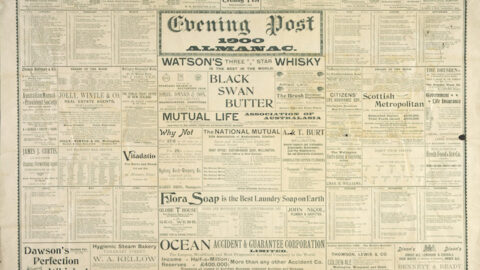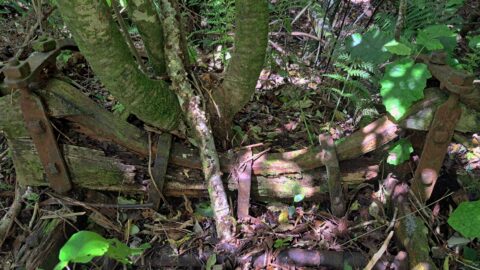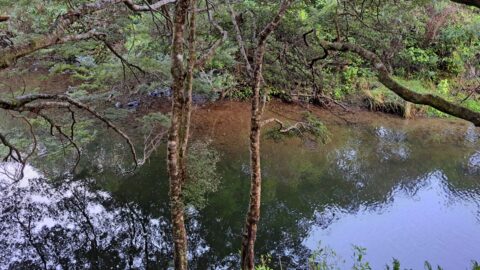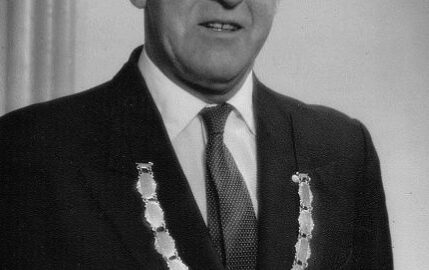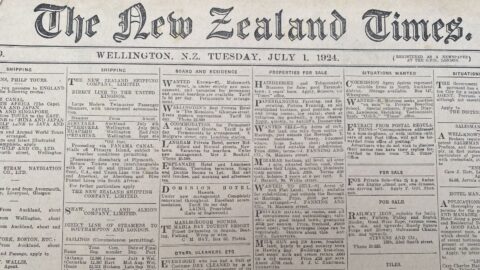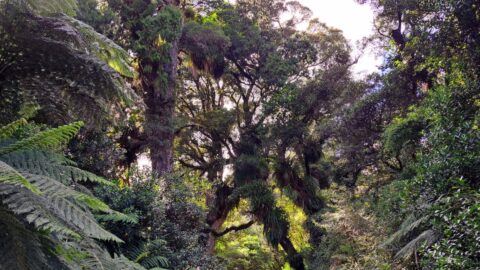A Trip to the Wainui Watershed
[By our Special Reporter]
I have come to the conclusion that one may do many worse things than go on an official excursion with a Corporation or a local government body of any description. It must have been rather good fun on May Day in the good old times of King Henry VIII to go into the weald of Kent to gather the May with the Lord Mayor and Corporation of London, and afterwards to meet the King and Queen on Shooter’s Hill – that is to say, if his Majesty happened to be in a good humor, and did not feel inclined to have a few heads off. It is by no means a disagreeable experience in the present day to go with the Lord Mayor and Corporation of London on their quaint annual trip to Epping Forest. I have even derived much pleasure from assisting parochial officials at Home in “beating the bounds” of the parish, my enjoyment being immensely heightened by the exhilarating spectacle of the “bumbing” of two churchwardens.
This impressive and dignified ceremony consisted in their being taken by the arms and legs and swung, so that a vulnerable portion of their body comes into violent contact with a tree or stone wall, this being a time-honored custom on these occasions. I have a not-at-all unpleasant recollection of visiting, in the company of a whole host of civic and other dignitaries, one of the last places one would select in which to spend a happy day – namely, a sewage farm. I must confess that this was an undertaking I approached with a somewhat diffident spirit. However, duty must be done, and the patent Syphonostomatic process (I won’t tell tales and reveal its real name) had to be inspected at all hazards, since we were told that this was the plan which was to settle at once and forever the great crux which was driving local bodies in all parts of the world to the verge of desperation.
Arrived at the railway station, we found that the thoughtful Syphonostomatic Company had provided us with a special train, and we discovered comfortable carriages awaiting us at the terminus to which we were booked. On arriving at the works, we found an extremely urbane gentleman – the chairman of the company – ready to do the honors, in which he was assisted by another urbane gentleman of exceedingly scientific aspect – the consulting chemist, I believe he was. We went into the laboratory of the latter, where we performed some extremely interesting experiments with sherry and biscuits, and then we made a tour of the works. Everything, of course, was in apple-pie order for our visit – which took place on a clear frosty day. We were enthusiastic about the success of the process and its perfect freedom from annoyance, and one gentleman, in a daring spirit of scientific investigation, actually went so far as to taste some of the effluent water! He said it had only a slight flavor of lime. I was perfectly willing to accept his word for it and did not venture to contradict his statement.
We had a pleasant drive around to see the principal objects of interest in the neighborhood, and this was followed by a charming champagne luncheon. We then became even more enthusiastic about the success of the process and predicted the most wonderful results to follow from it. However, I am sorry to say that despite all this, the disposal of sewage is still an unsolved problem, and the Syphonostomatic Company has long since been wound up.
I went with the Wellington City Council on Saturday to inspect the source of the proposed new water supply and have come to the conclusion that they also are not half-bad fellows to go out with. Some of them are truly awful to contemplate in the Council Chamber – such dragons of virtue are they, and so terrible in their denunciations of each other’s iniquity. Still, it is astonishing how harmless and jolly you find them when they relax from the cares of state. There were seven of the City Fathers in the party – Messrs Maginnity, Miller, Greenfield, Danks, Young, Fisher, and Allen. We were accompanied also by the genial City Engineer, Mr. Baird, and his able assistant, Mr. Barton. The drive through the Hutt, as far as Wainui-o-mata hill, was devoid of incident, but here a serious difficulty confronted us.
The ‘difficulty’ consisted of Messrs Sinclair’s new locomotive engine, “Pio Pio,” which had been dragged out here with great labor but was now blocking the road, apparently without any hope of getting it further. We subsequently saw a dozen powerful bullocks have a spell at it, but they gave up in disgust. Consequently, it seems very probable that either the engine will have to be taken over the hill piece-meal, or else nothing less than a convulsion of nature will be able to move it. At first, it appeared doubtful whether the trip would not have to be abandoned. However, our driver was an Irishman and, therefore, a man of infinite resource. He soon confided to us that he could take the traps around another way through some paddocks but mentioned that the principal preliminary step necessary to the complete success of the plan was that we should all walk right up to the top of the hill.
The road was about three miles long and rose goodness knows how many feet above the level of the sea, but we complied with his request, although we could not exactly see why it was necessary, inasmuch as the traps were bound to come into this road by a track only a few yards above the engine. We found out the secret afterward, however – it was merely a diplomatic “move” on the part of that astute Jehu to save his horses! Still, a merciful man is merciful to his beast, and I, for one, quite forgave that designing driver, as we trended our way upwards through a profusion of shrubs and saw the beautiful panorama unfolded at our feet. There was the beautiful bay, with the entire sweep to the right as far as the eye could reach edged with a creamy line of foam, caused by the surf breaking on the beach. Still further to the right lay the valley of the Hutt, with the Hutt and Waiwetu Rivers crossing the plain like silver threads, while the hills around formed a pleasing background to the picture.
Besides, riding along this road, as we discovered afterward, is not without its drawbacks. It is too dangerous to be pleasant, and a broken spring testified to the peril of trusting oneself in a light buggy along such a track with a load of portly City Councillors. We had picked up Mr. Duncan Sinclair en route, and he very kindly consented to accompany us to the stream to “show us around.” And a very great acquisition we found him – his courtesy and knowledge of the country rendering our visit twice as agreeable as it otherwise would have been.
We soon bowled along across the somewhat dreary-looking plain of the Wainui, past a primitive little burying ground, where sleep two of the pioneers of the Valley – Mr. and Mrs. Sinclair, sen. – and then we reached the sawmills. The inhabitants of Wainui-o-mata acquired additional interest in our eyes when we were told that they were all Wesleyans and had no public houses in the Valley. One of the party suggested that, as we had a slight stock of liquid refreshment “on board,” we might do a good stroke of trade with these primitive people. This ribald proposal is, however, I am glad to say, scouted with the contempt it deserves – especially by the thirstier of the travelers.
Arrived at the sawmills, we had a picnic, with the large logs serving capitally as tables and seats. Now were our City Fathers in the height of good humor, and many a roar of laughter awoke the silence of the Valley. One Pater conscriptus in particular shone at his brightest. The peculiarity about him was that, whenever anyone needed a corkscrew, it was produced with lightning-like rapidity, equaled only by the speed with which he could evolve a joke on any conceivable subject.
It must be confessed that the scenery just at this spot was the reverse of exhilarating. All the beautiful bush on the hills had been destroyed by fire, and the charred logs lay strewn in thousands on the slopes, giving one the idea of corpses on a battlefield. However, there is lovely virgin bush further up the gully where it is proposed to erect the dam to intercept the stream, which comes babbling down past the mills as clear as crystal. A guarantee of its purity is afforded by the fact that Mr. Sinclair has succeeded in rearing some English trout in it. Occasionally, some of the speckled beauties, nearly a foot long, are seen flashing about in the water, and before long, there should be fine sport for the angler.
We were told by Mr. Sinclair that it was only a mile and a half up the gully to the site of the dam. Some of the City Fathers, however, were ready to take their solemn affidavit afterward that it was not an inch short of 14 miles. As a truthful chronicler, it is also my duty to add that Mr. Sinclair – who, of course, is an experienced bushman – was a perfect *ignis fatuus* in the way he lured his civic guests to their destruction. He and the City Engineer – who is also experienced in the mysteries of the bush – would hop lightly over fallen logs and trip airily across treacherous bogs without ever making a false step or wetting the soles of their boots. The City Fathers, however, barked their shins and selected the softest parts of the morasses with a unanimity that was really wonderful.
Our destination, notwithstanding, was reached at last, and the party gazed at the stream much as Stanley must have looked at the source of the Congo. Maps were produced by Mr. Baird and Mr. Barton, and what was proposed to be done was clearly explained. A dam and a tail-race were to be constructed here, and the water would enter the pipes, as at present arranged, near Captain Mowlem’s, farther down the valley.
After being carried by a tunnel a quarter of a mile long through Sulky Hill, the main would go across the plain again, piercing the hill by a tunnel 27 chains long, and coming out by the side of the spur over which we had passed; thence it would be laid along the front of the race-stand, through Petoni, Ngahauranga, and on to Wellington. The proposed receiving basin will be 350 feet above sea level, so that, as may be imagined, there will be a splendid pressure available. The water is very clear, passing through 9000 acres of virgin forest, reserved to the Council by the Government, and over a bed composed of nothing but shingle and stone.
It was at its lowest level when we saw it, being the height of summer, but even then it was a bawling stream many times larger than that which presently supplies the city. The visitors were fully satisfied, in fact, that it would more than fill the two-foot main which it is proposed to construct. In the winter, the stream becomes a mountain torrent, but even then, Mr. Sinclair informed us, the water preserved its purity. If, as Tennyson assures us, the nature of brooks is to “go on forever,” there ought to be no fear of Wellington being deficient in the matter of water supply.
If, however, it should for any reason become insufficient, a tunnel of ten chains would turn the Orongorongo, a neighboring stream, into it, and so double its volume. We followed up one of its tributaries, “George Wood Stream,” and there, in the midst of some picturesque bush, Mr. Sinclair showed us some quartz which had yielded gold at the rate of 2½ to 14 dwts to the ton, although no one has yet been able to discover the reef.
The shades of evening were falling when the party returned to town, with the gratifying reflection that they had gained a good deal of useful information from the visit. There is no doubt that the members of the Council will now be able to discuss the matter in a much more intelligent manner than if they had never visited the spot.
Tags: Dams Fishing Logging Newspaper Pio Pio Pipeline Prospecting Sinclair Tunnels Water Race Waterworks
